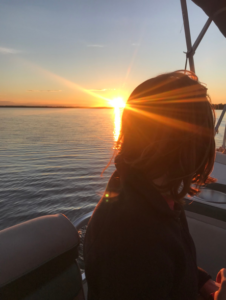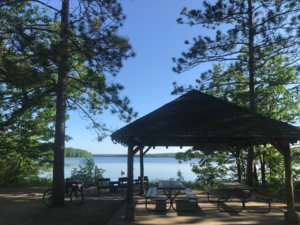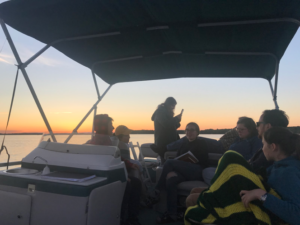
From Left to Right: Eva Roos, Cielle Waters-Umfleet, Kiersten Hoff, Katie Beekman, Candace Hulbert, Jessie Willams, Andie McNally, Joseph Behnke, and Ingrid Diran
What makes a place, a place?
That is the question that the Great Lakes, Arts, Cultures and Environments (GLACE) program is engaging students with through the interdisciplinary humanities program. The program celebrated its first cohort last spring and now is recruiting the next group for spring term at the University of Michigan Biological Station (UMBS), where students can gain eight interdisciplinary credits.
A Special Place for Learning
“I don’t think you can take a program like GLACE and put it in Ann Arbor and have it work the same way. We went on trips all the time to historic Native

Pictured: Candace Hulbert
American sites and had discussions on why these places are significant; we went on nature walks and talked about the trees that are only found in Northern Michigan; we had lessons on how to identify certain plants just by the shape of leaves. You never knew what you were going to learn every way, whereas if you were in a class here,” said Candace Hulbert, LSA senior in English Language and Literature and political science, “Everything is very scheduled. We had a lot of freedom. We had the bow of the boat in our learning.”
In the arc of six weeks, students learned from U-M faculty and other instructors, but were also given a certain level of autonomy and agency in their learning. Students were often encouraged to bring in their own readings into the classroom to discuss, to explore the UMBS and surrounding areas as part of their learning, and were given open-ended assignments that allowed them to think creatively about how they wanted to engage with the topic.
“The students became their own teachers,” said Ingrid Diran, GLACE program director and assistant professor in Comparative Literature and Program in the Environment. “Rather than it being unilateral teaching, we developed a collective authorship of the space.”
Those eight credits students gain are taught in four interconnected, two-credit courses in English, Anthropology and American Culture. The four instructors of the program each provide a new lens to analyze what makes a place, such as expression through writing and art installations, cartography and map making, Anishinaabeg — the group of indigenous people residing in Canada and the Great Lakes area — linguistics and culture.
“The GLACE program really taught me about the interaction of place, people, and yourself and how you place yourself within the context of the actual place you’re in, yourself in context with people, and the way the three work together,” Hulbert said, “I never thought about how important place was before I did the GLACE program.”
An immersive opportunity
“My favorite part of the program was the immersive experience,” said Jessie  Williams, LSA sophomore in Environment and Communication & Media. “Being from Northern Michigan and being familiar with the area made it even more surprising when I felt like I was learning about the area for the first time. Specifically, the field trips we took to places such as Sleeping Bear Dunes and Mackinac Island through the lens of everything we’d learned through our classes, made the experiences much more meaningful and allowed us to look through a critical lens. I still find myself applying the principles of social science that I learned through GLACE whenever I visit a new place, or whenever I’m feeling particularly contemplative about Ann Arbor or my hometown in Traverse City.”
Williams, LSA sophomore in Environment and Communication & Media. “Being from Northern Michigan and being familiar with the area made it even more surprising when I felt like I was learning about the area for the first time. Specifically, the field trips we took to places such as Sleeping Bear Dunes and Mackinac Island through the lens of everything we’d learned through our classes, made the experiences much more meaningful and allowed us to look through a critical lens. I still find myself applying the principles of social science that I learned through GLACE whenever I visit a new place, or whenever I’m feeling particularly contemplative about Ann Arbor or my hometown in Traverse City.”
The UMBS research campus is a unique location for a humanities program, and provides a distinctive opportunity for GLACiERs, the self-dubbed name of participants of the program, to live and work alongside students from an array of scientific backgrounds such as ecology, geology, climatology and microbiology. GLACiERs are able to bring a refreshing voice to discussions on the natural world and approaches to understanding it.

While scientific researchers were collecting data in the lab, GLACiERS were conducting their own studies. They created audible maps, drew portraits of the night sky, taught peers how to introduce themselves in Anishinaabemowin, and interviewed members of the community ranging from UMBS director Knute Nadelhoffer to a Bracken fern, lovingly named Herb. The aim of the assignments is to be able to utilize data and traditional parameters and produce an innovative method of analyzing the natural world through a humanities lens.
“The program completely flipped my worldview, and the way I interact with the natural world around me,” Williams said. “Learning about Anishinaabeg views of respect for the environment, including the agency of individual plants and animals, has made me include many new factors in how I try to engage sustainably with the world around me.”
One of the main tenets of GLACE is on field-based learning, so students hike, swim, take trips and explore the land surrounding Douglas Lake and the UMBS. This approach is to encourage students to think critically about what they learn from the land, the people and the culture instead of simply learning about it in the traditional classroom.
“The shift from learning about to learning from I think can very much be a way that the experience of the classroom changes,” Diran said. “Students have an opportunity to ask questions about what learning actually teaches them […] that pushes them beyond the boundaries of a given class and empowers them as their own thinkers, questioners, scholars, citizens. If there’s one hope for what GLACE accomplishes, it’s that it returns students to Ann Arbor as stewards of their own education.”
A Community of Students
“[GLACE] was the best six weeks of my life. It was a very unique academic experience because it feels like community-based learning isn’t something you would be able to typically see at a big university like Michigan,” said Joseph Behnke, LSA senior in English Language and Literature. “It was really awesome to be able to go in with this group […] and be together in such a unique place,  there’s nothing like it. I’m a transfer student and I don’t live on campus, so being able to be there as part of a community was really great.”
there’s nothing like it. I’m a transfer student and I don’t live on campus, so being able to be there as part of a community was really great.”
While students had access to modern capabilities such as wifi and general internet, the bulk of experiences GLACiERs had involved a certain amount of remoteness.
“We were mostly in places where the best wireless signal you have is to the person next to you,” Diran said.
Being somewhat removed from society was not the purpose of the program, but was a unique factor that allowed students to foster close relationships and personal experiences together. Students stayed in rustic cabins, worked in a classroom with just a whiteboard and a wood-fire stove to stay warm, and used observing their surroundings as a key component of their learning. During their time in Northern Michigan, GLACiERs took trips to Sleeping Bear Dunes, Mackinac Island, and day trips out on Douglas Lake.

From left to right: Andie McNally, Katie Beekman
“I hope students come out with the tools to reassess conventions they didn’t even see were present in their lives, and to have that lens to see your assumptions, and be open to changing your mind,” said Eva Roos, assistant director of GLACE and master’s student in the School for Environment and Sustainability.
The application deadline for GLACE is March 13, 2020. The English Department has also received support from generous donors for GLACE specific, need-based scholarships to assist with the associated costs of the program. For more information on the program, reach out to program director Ingrid Diran at idiran@umich.edu.


